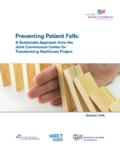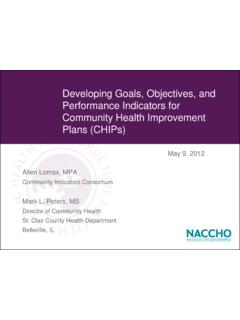Transcription of Creating Effective Hospital- Community Partnerships to ...
1 Creating Effective hospital - Community Partnerships to Build a Culture of Health Suggested Citation: Health Research & Educational Trust. (2016, August). Creating Effective hospital - Community Partnerships to build a Culture of Health. Chicago, IL: Health Research & Educational Trust. Accessed at Accessible at: Contact: or (877) 243-0027. 2016 Health Research & Educational Trust. All rights reserved. All materials contained in this publication are available to anyone for download on , or for personal, non-commercial use only. No part of this publication may be reproduced and distributed in any form without permission of the publication or in the case of third party materials, the owner of that content, except in the case of brief quotations followed by the above suggested citation.
2 To request permission to reproduce any of these materials, please email 2 Creating Effective hospital - Community Partnerships to Build a Culture of Health Table of Contents Executive Building Partnerships Around Community Health CHNA-driven Enhancing Existing Initiating New hospital and Community Organization Partnership Effective Leadership, Governance and Organizational Aligned Mission, Vision and Clearly Defined Roles and Operational Structures and Programs and Interventions to Address Community Assessment of Interventions and the Overcoming Obstacles in Partnership Creating an Effective and Sustainable Case Study 1 SouthEast Alaska Regional Health Consortium Juneau, Case Study 2 Indiana University Health Indianapolis, Case Study 3 PIH Health Whittier, Case Study 4 Cook Children's Health Care System Fort Worth, Case Study 5 Duke University hospital Durham, North Case Study 6 West Tennessee Healthcare Jackson, Case Study 7 Montrose Memorial hospital Montrose, Appendix A: Survey Appendix B: Partnership Results from the AHA/ACHI Population Health Appendix C: The hospital 's Role in Appendix D: Health Impact Collaborative of Cook County Appendix E: Duke Health Division of Community Health Partnership Appendix F: coalition Member Creating Effective hospital - Community Partnerships to Build a Culture of Health 3.
3 Executive Summary Effective and sustainable hospital - Community Partnerships are critical to building a Culture of Health. Building a Culture of Health means Creating a society that gives all individuals an equal opportunity to live the healthiest life they can, whatever their ethnic, geographic, racial, socioeconomic or physical circumstances may be. To understand the variety of ways that hospitals and communities can develop and sustain Partnerships , the Health Research & Educational Trust (HRET), with support from the Robert Wood Johnson Foundation (RWJF), conducted 50 interviews with hospital , health system and Community leaders from 25 diverse communities. These interviews resulted in lessons learned and best practices in identifying Community health needs, potential partners, and sustainable partnership structures, as well as recommendations for overcoming obstacles and challenges and assessing Partnerships .
4 Though some Partnerships develop organically, a catalyst event such as the initiation of a Community health needs assessment process, new policies or payment models, or emerg- ing Community health issues often brings organizations together or revitalizes long-stand- ing Partnerships . Hospitals and health systems also are seeking out new and nontraditional partners, such as grocery stores, food banks, 2-1-1 centers and local police departments, to address a wide range of Community needs. As new Partnerships form, there is a need for increased structure and Effective operations for the Partnerships . It is critical to define goals based on the Community 's health needs when building an Effective partnership. When partners come together to address an identified priority health need of the Community , the goals and objectives of the partnership should be agreed upon and understood by all partners.
5 The most appropriate governance and orga- nization structure can then be developed, with all partners understanding their distinct role in the collaborative approach to addressing their Community 's health needs. Shared gover- nance can take the form of steering committees, advisory boards, joint ventures, coalitions and a variety of more informal structures. With a strong organizational structure and identi- fied goals, objectives and roles, these Partnerships can effectively develop evidence-based interventions. Creating Effective Partnerships within communities also includes evaluating the interventions and the partnership itself. Successful Partnerships , including those highlighted in this guide, evaluate the effectiveness of their interventions by using process and outcome metrics.
6 Ad- ditionally, hospitals and Community organizations are beginning to assess the effectiveness of their Partnerships through surveys and such resources as coalition member assessments. hospital - Community Partnerships face some common barriers and challenges, including lim- ited funding, lack of structure, differing organizational cultures, disparate data collection and storage, limited operational resources, and the need for leadership and organizational buy-in. Overcoming these barriers and challenges is necessary to have a positive impact on the effectiveness and sustainability of the interventions. Using a systematic process for forming Effective Partnerships will ensure that all functions and operations for the partners are identified and established.
7 These functions include structure, communication, repre- sentation, funding and other partnership activities. 4 Creating Effective hospital - Community Partnerships to Build a Culture of Health Figure 1 outlines strategic considerations for Creating an Effective and sustainable hospital - Community partnership to build a Culture of Health. Figure 1: Strategic Considerations for Creating an Effective and Sustainable hospital - Community Partnership Partnership Leadership and Governance Develop an informal or formal governance/steering group ( , coalition , board, com- mittee) with individuals representing each partner organization. Obtain support and commitment from each partner's CEO, senior management team, board of trustees and other key leaders. Develop succession plans with current and future leaders so the partnership does not rely entirely on one person or organization.
8 Get agreement with all partners on mission, vision, goals, objectives and appropriate intervention strategy. Draft any legal agreements or memorandums of understanding to solidify the part- nership structure, as needed. Present return-on-investment case to leadership at all organizations. Partnership Structure and Culture Clearly define roles and responsibilities of each partner. Convene active workgroups and committees that focus on execution and continually work to address challenges and barriers. Engage partners in collaborative problem-solving of jointly shared problems. Discuss lessons learned on an ongoing basis to modify and strengthen partnership structure and processes. Ensure transparent and frequent communication between partners and other key stakeholders.
9 Regularly conduct informal reviews ( , Plan-Do-Study-Act cycle) of partnership quality to identify any areas for improvement. Creating Effective hospital - Community Partnerships to Build a Culture of Health 5. Partnership Program Development and Implementation Identify health needs through a Community assessment, with participation or input from key partners. Develop programs based on prioritized Community health needs. Ensure partners agree on the scope of the interventions ( , focus on a few targeted conditions/drivers or a comprehensive range of health and sociological issues). Identify any evidence-based interventions and promising practices for the identified need, and agree upon process and outcome metrics. Identify Community assets to determine all available resources ( , financial, time, facility space, staff, IT, in-kind or other resources) and potential partners.
10 Identify and apply for secure, sustainable funding. Consider pilot grants if long-term funding is unavailable. Tracking Partnership Outcomes Adopt a partnership assessment survey tool to periodically gauge partnership satisfaction. Measure the impact of the partnership's efforts on the stated goals. Select process measures to signal progress toward the long-term goal. Share data among partners, particularly data on partnership goals. Share data with Community stakeholders and Community members to demonstrate progress. Ensure that partners measure the perceived quality and impact of the partnership to improve health. Evaluate how the partnership facilitates ongoing Community relationships. Celebrate successes and communicate stories broadly. Source: HRET, 2016.
















